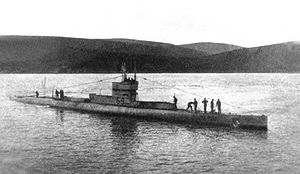|
British G-class submarine
The G-class were a series of diesel-electric submarines of the Royal Navy in World War I They were launched between 1914 and 1917, and intended for operations in the North Sea and German Bight against German U-boats. DescriptionThe G-class submarines were designed by the Admiralty in response to a rumour that the Germans were building double-hulled submarines for overseas duties. The submarines had a partial double hull, a length of 187 feet 1 inch (57.0 m) overall, a beam of 22 feet 8 inches (6.9 m) and a mean draft of 13 feet 4 inches (4.1 m). They displaced 703 long tons (714 t) on the surface and 837 long tons (850 t) submerged. However, the design offered little improvement in practice, the ships being notoriously slow to dive.[1][2]  Most of the class had their bows raised during the war to increase buoyancy and improve seakeeping. For surface running, the boats were nearly all powered by two 800-brake-horsepower (597 kW) Vickers two-stroke eight-cylinder diesel engines, each driving one propeller shaft. These engines were the first in the world to use Common Rail injection, using four plunger pumps to deliver a pressure up to 3,000 pounds per square inch (210 bar; 21 MPa) every 90° of rotation to keep the fuel pressure adequately constant in the 'rail' (pipe) serving all eight cylinders.[3] G14 was initially powered by FIAT diesels, but these proved unsuccessful, and were replaced by the standard Vickers engines. It was originally intended to fit more efficient four-stroke MAN and Sulzer diesels to some of the class, but the outbreak of hostilities rendered such plans impossible.[4] When submerged each propeller was driven by a 420-horsepower (313 kW) electric motor. They could reach 14.25 knots (26.39 km/h; 16.40 mph) on the surface and 9 knots (17 km/h; 10 mph) underwater. On the surface, the G class had a range of 2,400 nautical miles (4,400 km; 2,800 mi) at full speed.[5] The boats were originally intended to be armed with one 21-inch (53.3 cm) torpedo tube in the bow and two 18-inch (45 cm) torpedo tubes on the beam. This specification was revised while they were under construction, the 21-inch tube moved to the stern and two additional 18-inch tubes added in the bow; they carried two 21-inch and eight 18-inch torpedoes. The G-class was also armed with a single 3-inch (7.6 cm) deck gun.[5] The G-class submarines had a crew of 30 officers and ratings.[5] BoatsA total of 14 boats were built at four yards: G1 to G5 by Chatham Dockyard, G6 & G7 by Armstrong Whitworth, G8 to G13 by Vickers, and G14 by Scott's on the Clyde. G15 was ordered from Samuel White's yard at Cowes, Isle of Wight, but cancelled.[6]
Notes
References
External links
|
||||||||||||||||||||||||||||||||||||||||||||||
Portal di Ensiklopedia Dunia
